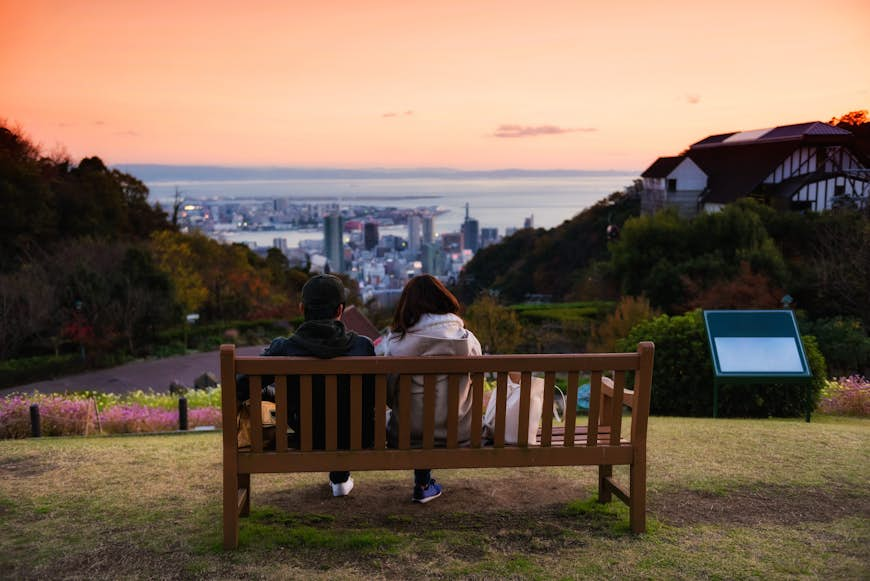
Kyoto, the ancient capital of Japan, is captivating in its own right: from the sprawling Fushimi Inari-Taisha shrine to the Arashiyama Bamboo Grove in the western suburbs. But its location at the heart of the Kansai region makes it a great base for exploring farther afield, including nearby castles and fabled hot springs.
These are the very best day trips from Kyoto. Each one is accessible by train in under two-and-a-half hours. If you plan to make several trips within a five-day period, consider buying a Kansai Wide Area Pass. Most routes are also covered by a Japan Rail Pass.
Discover the world’s most intriguing experiences with our weekly newsletter delivered straight to your inbox.
Secret Marvels: Nara Park, Japan
Visit the historic sites of peaceful Nara
Travel time: 1 hour
One of the most popular day trips from Kyoto, tranquil Nara is home to some of the country’s most historical sites. This was Japan’s first permanent capital, so it teems with important temples, shrines and Buddhist art. Arrive early and you can see its highlights in a single day.
Don’t miss the massive Todaiji temple and the lantern-lined Kasuga Shrine. While making your way to leafy Nara-kōen, the park famed for its free-roaming, inquisitive deer, stroll through exquisite Japanese gardens at Yoshiki-en. Nearby Isui-en has a prime example of shakkei – the Japanese concept of borrowed scenery – with Mt Wakakusa rising up as the garden’s backdrop.
How to get to Nara from Kyoto: From Kyoto Station, take a 55-minute rapid train on the JR Nara line to Nara Station.
 Osaka: arrive hungry and be ready to eat © Vincent St. Thomas / Shutterstock
Osaka: arrive hungry and be ready to eat © Vincent St. Thomas / Shutterstock
Osaka is the best place to try Japanese cuisine
Travel time: less than 30 minutes
Osaka is known in Japan as “the nation’s kitchen”, so arrive from Kyoto hungry. Its kuidaore motto literally means “to eat oneself bankrupt”. Chow down on okonomiyaki (savory pancakes) and takoyaki (fried octopus balls) along the Dotombori River and/or try kushikatsu (fried meat and vegetable morsels on sticks) near the Tsutenkaku Tower in the kitschy, neon-lit neighbourhood of Shinsekai.
Wind through the alleys of Ura-Namba to Torame Yokacho (Tiger Alley) too, where you can try myriad favorite dishes under one roof. When full, walk off your excesses in the expansive grounds of Osaka Castle or browse boutique and vintage clothing shops in the hip hoods of Amerika-Mura, Horie, and Nakazakicho.
How to get to Osaka from Kyoto: From Kyoto Station, take a JR special rapid train bound for Himeji to Osaka Station. Bullet trains also run between Kyoto and Osaka.
 Kōbe is one of Japan’s most attractive cities © Shutterstock / Blanscape
Kōbe is one of Japan’s most attractive cities © Shutterstock / Blanscape
Kōbe is a city on the edge of nature
Travel time: 1 hour
Kōbe is one of Japan’s most attractive cities. At the heart of the city are the popular retail districts of Motomachi and Sannomiya, but head uphill from Sannomiya Station and an area of tree-lined streets with merchant houses, quaint cafes, and unique shops soon unfurls.
Despite a population of 1.5 million, Kōbe offers easy access to nature. Mt Rokko, a popular hiking spot (accessible by cable car too), towers over the city’s narrow streets whilst Nunobiki Falls has been a muse for artists, poets and worshippers for centuries. If you have time, consider a side trip to Himeji-jō, Japan’s most magnificent castle.
How to get to Kōbe from Kyoto: From Kyoto Station, take a JR Limited Express Super Hakuto train for 50 minutes to Sannomiya Station.
 The Atomic Bomb Dome in Hiroshima has been preserved as a memorial to the atomic-bomb attack of 1945 © Chase Davidson / 500px
The Atomic Bomb Dome in Hiroshima has been preserved as a memorial to the atomic-bomb attack of 1945 © Chase Davidson / 500px
Explore Hiroshima’s Peace Memorial Park and beyond
Travel time: under 2 hours
Hiroshima may be synonymous with the devastating atomic-bomb attack in 1945, but this leafy, laid-back city has much more to offer visitors these days than just its past. If you want to pay homage to the blast victims, go to the Peace Memorial Park and then take in the haunting Atomic Bomb Dome, one of very few buildings left standing near the epicenter. Its shell has been preserved as a memorial.
A good pick-me-up afterwards is the short trip over to the gorgeous island of Miyajima, home to Itsukushima, a bright orange shrine rising out of the ocean. This celebrated spot is considered one of the three great views of Japan (alongside the Amanohashidate sandbar and the islands of Matsushima). From here, you can wander through streets lined with machiya (old wooden townhouses) and take a cable car up to the summit of Mt Misen for breathtaking views of the Seto Inland Sea.
How to get to Hiroshima from Kyoto: From Kyoto Station, take the one hour and 40 minute Shinkansen Nozomi bullet train to Hiroshima. To reach the ferry port from Hiroshima Station, take the JR Sanyo Line for 25 minutes to Miyajimaguchi Station.
 Get out on Lake Biwa on a visit to Shiga Prefecture © YEH, YUNG-HUNG / Getty Images
Get out on Lake Biwa on a visit to Shiga Prefecture © YEH, YUNG-HUNG / Getty Images
Maibara in Shiga Prefecture is the perfect day trip for outdoor adventure
Travel time: under 30 minutes
Just across the Higashiyama mountains, Shiga Prefecture is dominated by Japan’s largest lake, Biwa-ko (Lake Biwa), the bucolic inspiration for centuries of poets. Whilst few today will dream up haikus detailing the kayaking, stand-up paddle boarding and cycling that attracts most visitors, it still makes for a wonderful, adventure-fuelled day trip from Kyoto.
Take the train to Maibara Station and hire a bicycle there. Pedal south to the charming little town of Hikone and climb up to its castle, the 17th-century Hikone-jō, for spectacular views out across the lake. Or cycle north to Nagahama, which perches on the northeast coast, with highlights including the reconstructed Nagahama Castle on the waterfront.
How to get to Maibara from Kyoto: From Kyoto Station, take a one-hour rapid train or 20-minute bullet train on the JR line to Maibara Station.
 Kinosaki Onsen is where visitors can really unwind © Rei Imagine / Shutterstock
Kinosaki Onsen is where visitors can really unwind © Rei Imagine / Shutterstock
Kinosaki Onsen is the best relaxing day out
Travel time: 2.5 hours
If the Kyoto crowds get a little too much, Kinosaki Onsen on the Japan Sea coast is the ideal stressbuster. With seven public bathhouses and a whole host of private ones, this beautiful willow-lined canal town is awash with relaxing hot springs that are famed for their remedial properties and promises of good fortune.
With an entrance designed to look like the Kyoto Imperial Palace, Gosho-no-yu is the town’s most famous bathhouse, and its most busy too. Kinosaki boasts rotemburo (outdoor baths) and single-person baths too. If here in winter, enjoy a feast of snow crab freshly caught from the Sea of Japan. Many of the ryokans (traditional Japanese inns) serve delectable kaiseki (Japanese haute cuisine) multi-course crab meals, which are delicious works of art.
How to get to Kinosaki Onsen from Kyoto: Take the Limited Express Kinosaki train to Kinosaki Onsen Station.
 Experience Kurashiki from the water with a canal boat ride © Sean3810 / Getty Images
Experience Kurashiki from the water with a canal boat ride © Sean3810 / Getty Images
Take a traditional canal boat tour in Kurashiki
Travel time: 90 minutes
An important trading post during the Edo period (1603–1867), much of Kurashiki’s character comes from its historic black-and-white warehouses that line its willow-edged canal. Those buildings — many now converted into museums, cafes, and art workshops — make up the atmospheric Bikan quarter.
Wander the laneways lined with old wooden houses and shops first, before popping into the popular Ōhara Museum of Art, which has works by Picasso, Cézanne, and Matisse. A traditional boat tour of Kurashiki Canal is a lovely way to pass the afternoon, or else head to Ivy Square, the pretty courtyard that once housed textile factories, but now often has entertainment on.
How to get to Kurashiki from Kyoto: Ride the Shinkansen Nozomi bullet train to Okayama Station then change to the JR Sanyo line. The connection to Kurashiki Station takes around 20 minutes.
 Nagoya is the birthplace of Toyota with two dedicated museums © f11photo / Shutterstock
Nagoya is the birthplace of Toyota with two dedicated museums © f11photo / Shutterstock
See the shrines and museums of Nagoya
Travel time: 35 minutes
Don’t listen to the naysayers who label Nagoya as “Japan’s most boring city.” Most have never even been. This manufacturing powerhouse, just over half an hour from Kyoto, is a cosmopolitan curio that flexes its muscles with some fantastic museums, seafood to just die for, and an unpretentiousness you won’t find in Tokyo and Osaka.
Day-trippers will want to visit the 1900-year-old Atsuta-jingū, one of the most sacred Shintō shrines in Japan, as well as the engrossing International Design Centre Nagoya, which weaves riotously from art deco to postmodernism, Arne Jacobsen to the Mini Cooper.
Birthplace of Toyota, there’s plenty for petrol heads to admire, including two museums that celebrate the world’s largest car manufacturer. If you’re short on time, steer towards Toyota Kaikan Museum to see the latest wheels roll off the production line.
How to get to Nagoya from Kyoto: Nozomi trains take around 35 minutes to reach Nagoya.
 Kōraku-en in Okayama is one of the finest landscaped gardens in Japan © Artem Smetanin / 500px
Kōraku-en in Okayama is one of the finest landscaped gardens in Japan © Artem Smetanin / 500px
Wander Okayama’s stunning garden before hitting the “Kitchen Runway”
Travel time: 1 hour
A little under two hours from Kyoto, Okayama is often seen as a short diversion before travelers chug on down to Hiroshima, however it can make for a fantastic day trip as well. Most visitors are only here for Kōraku-en, one of Japan’s prettiest gardens, but there’s enough here to spare a few hours more.
As gardens go, it’s a corker. In spring the groves of plum and cherry-blossom trees are stunning, in summer white lotuses unfurl, and in fall the maple trees are a delight for photographers. You can explore its expansive lawns, which are broken up by ponds, teahouses, and other Edo-period buildings, in around three hours.
However, what the one-sight wanderers don’t realise is that Okayama also has the best range of restaurants in the region. Those with rumbling tummies should stick around and follow the signs for the “Kitchen Runway”, a clutch of modern, casual restaurants.
How to get to Okayama from Kyoto: From Kyoto Station take the Nozomi train to Okayama Station. Bus 18 from Okayama Station drops you outside the garden (Kōraku-en-mae stop) in around 10 minutes.



